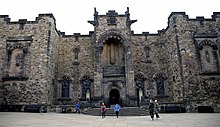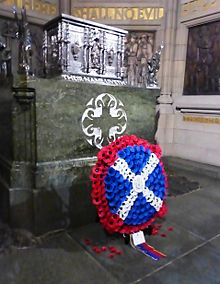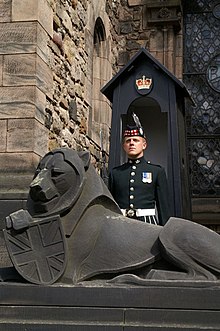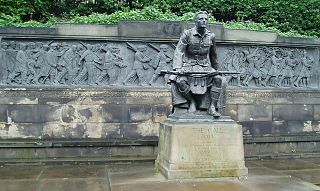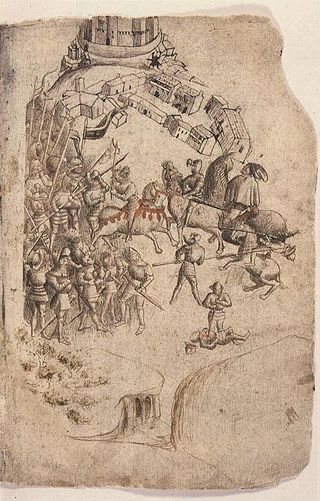
The Battle of Bannockburn was fought on 23–24 June 1314, between the army of Robert the Bruce, King of Scots, and the army of King Edward II of England, during the First War of Scottish Independence. It was a decisive victory for Robert Bruce and formed a major turning point in the war, which ended 14 years later with the de jure restoration of Scottish independence under the Treaty of Edinburgh–Northampton. For this reason, the Battle of Bannockburn is widely considered a landmark moment in Scottish history.
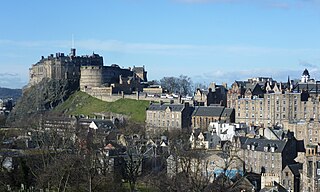
Edinburgh Castle is a historic castle in Edinburgh, Scotland. It stands on Castle Rock, which has been occupied by humans since at least the Iron Age. There has been a royal castle on the rock since at least the reign of Malcolm III in the 11th century, and the castle continued to be a royal residence until 1633. From the 15th century, the castle's residential role declined, and by the 17th century it was principally used as a military garrison. Its importance as a part of Scotland's national heritage was recognised increasingly from the early 19th century onwards, and various restoration programmes have been carried out over the past century and a half.

A war memorial is a building, monument, statue, or other edifice to celebrate a war or victory, or to commemorate those who died or were injured in a war.

St Giles' Cathedral, or the High Kirk of Edinburgh, is a parish church of the Church of Scotland in the Old Town of Edinburgh. The current building was begun in the 14th century and extended until the early 16th century; significant alterations were undertaken in the 19th and 20th centuries, including the addition of the Thistle Chapel. St Giles' is closely associated with many events and figures in Scottish history, including John Knox, who served as the church's minister after the Scottish Reformation.

Dalbeattie is a town in the historical county of Kirkcudbrightshire in Dumfries and Galloway, Scotland. Dalbeattie is in a wooded valley on the Urr Water 4 miles (6 km) east of Castle Douglas and 12 miles (19 km) south west of Dumfries. The town is famed for its granite industry and for being the home town of William McMaster Murdoch, the First Officer of the RMS Titanic.

William Angus VC, also known as Willie Angus, was a Scottish recipient of the Victoria Cross, the highest and most prestigious award for gallantry in the face of the enemy that can be awarded to British and Commonwealth forces.

Princes Street Gardens are two adjacent public parks in the centre of Edinburgh, Scotland, lying in the shadow of Edinburgh Castle. The Gardens were created in the 1820s following the long draining of the Nor Loch and building of the New Town, beginning in the 1760s.

Paisley Abbey is a parish church of the Church of Scotland on the east bank of the White Cart Water in the centre of the town of Paisley, Renfrewshire, about 7 miles west of Glasgow, in Scotland. Its origins date from the 12th century, based on a former Cluniac monastery. Following the Reformation in the 16th century, it became a Church of Scotland parish kirk.

Sir Robert Stodart Lorimer, KBE was a prolific Scottish architect and furniture designer noted for his sensitive restorations of historic houses and castles, for new work in Scots Baronial and Gothic Revival styles, and for promotion of the Arts and Crafts movement.
Alexander Carrick was a Scottish sculptor. He was one of Scotland's leading monumental sculptors of the early part of the 20th century. He was responsible for many architectural and ecclesiastical works as well as many war memorials executed in the period following World War I. As head of sculpture at Edinburgh College of Art, and as a leading member of the Royal Scottish Academy, Carrick had a lasting influence on Scottish sculpture.
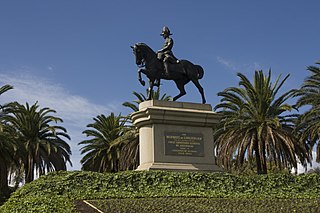
William Birnie Rhind RSA (1853–1933) was a Scottish sculptor.

St Andrew's Garrison Church, situated at Queens Avenue, Aldershot, Hampshire in southern England is a large army church designed in the late 1920s by the prominent Scottish architect Sir Robert Lorimer (1864–1929).

Scottish war memorials are found in all communities in Scotland. They are found on most main streets and most churches in Scotland. Many commemorate the sacrifice of the First World War but there are many others to wars before and since 1914–1918.

The Plymouth Naval Memorial is a war memorial in Plymouth, Devon, England which is dedicated to British and Commonwealth sailors who were lost in World War I and World War II with no known grave.
Charles d’Orville Pilkington Jackson RSA, FRBS, FRSA was a British sculptor prominent in Scotland in the 20th century. Throughout his career he worked closely with the architect Sir Robert Lorimer. He is most noteworthy for his creation of one of Scotland's most iconic landmarks, the statue of Robert the Bruce at Bannockburn.
John Marshall (1888–1952) was a Scottish sculptor active in the early 20th century. He is noted for doing much of his architectural work in-situ, on the face of the buildings.
Phyllis Mary Bone RSA was a 20th-century Scottish sculptor. She has the particular claim to fame as being the first female Academician of the Royal Scottish Academy. Although primarily the creator of small figurines, her works include several commissions at national level.

The Thistle Chapel, located in St Giles' Cathedral, Edinburgh, Scotland, is the chapel of the Order of the Thistle.

James Smith Richardson (1883–1970) was a Scottish architect, antiquarian and archaeologist. He was the first Inspector of Ancient Monuments for Scotland, and was responsible for a series of popular guidebooks to monuments in public care.

